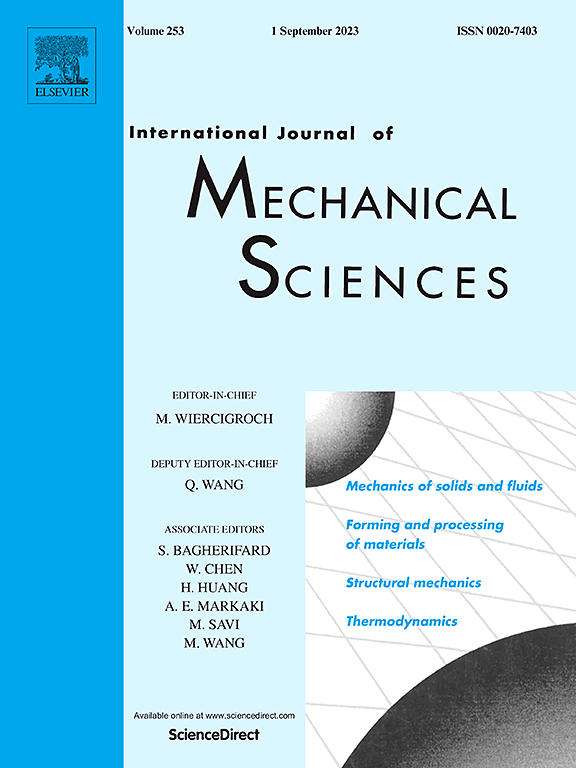Dynamic mechanical response and rupture mechanism of freeze-thawed jointed sandstones
IF 7.1
1区 工程技术
Q1 ENGINEERING, MECHANICAL
International Journal of Mechanical Sciences
Pub Date : 2025-03-03
DOI:10.1016/j.ijmecsci.2025.110117
引用次数: 0
Abstract
High-altitude cold regions are susceptible to the coupled effects of external freeze-thaw (F-T) and internal joints, leading to a series of rock-related disasters triggered by earthquakes and blasting activities. To investigate the dynamic mechanical response and rupture mechanisms of rock masses in cold regions, this study subjected intact, low-dip, couple-dip, and high-dip jointed specimens to cyclic F-T treatment, followed by dynamic loading using the split Hopkinson pressure bar system. A comprehensive discussion was conducted by integrating micro-parameters, multiple regression, and principal component analysis. The results indicate that F-T weathering accelerates the weakening of rock properties during later stages and lowers the energy threshold for failure, while rock masses containing high-dip joints can more readily meet the crack initiation conditions. In terms of energy, the utilization efficiency of sandstone is minimally impacted by F-T and joints, while the energy dissipation density exhibits a positive correlation with strain rate and a negative correlation with F-T cycles. Additionally, the digital image correlation technique was utilized to investigate the progressive rupture behavior of sandstone. Qualitatively, the technique elucidated the transition from brittleness to ductility induced by F-T cycles, as well as the shift from tensile to shear fracturing associated with joint geometries. Quantitatively, the analysis revealed a power-law acceleration pattern of high-strain areas prior to sandstone failure. Furthermore, on one hand, micro-damage analysis was employed to illustrate the synergistic deterioration of physical and mechanical properties in cold region rocks. On the other hand, a predictive model for dynamic strength was developed, revealing that fragmentation states are predominantly influenced by strain rate and secondarily by F-T damage. This overcomes the limitations of conventional methods that rely on single-parameter thresholds to distinguish failure modes. The present study establishes a comprehensive framework for evaluating dynamic instability mechanisms of jointed rocks in cold regions.

求助全文
约1分钟内获得全文
求助全文
来源期刊

International Journal of Mechanical Sciences
工程技术-工程:机械
CiteScore
12.80
自引率
17.80%
发文量
769
审稿时长
19 days
期刊介绍:
The International Journal of Mechanical Sciences (IJMS) serves as a global platform for the publication and dissemination of original research that contributes to a deeper scientific understanding of the fundamental disciplines within mechanical, civil, and material engineering.
The primary focus of IJMS is to showcase innovative and ground-breaking work that utilizes analytical and computational modeling techniques, such as Finite Element Method (FEM), Boundary Element Method (BEM), and mesh-free methods, among others. These modeling methods are applied to diverse fields including rigid-body mechanics (e.g., dynamics, vibration, stability), structural mechanics, metal forming, advanced materials (e.g., metals, composites, cellular, smart) behavior and applications, impact mechanics, strain localization, and other nonlinear effects (e.g., large deflections, plasticity, fracture).
Additionally, IJMS covers the realms of fluid mechanics (both external and internal flows), tribology, thermodynamics, and materials processing. These subjects collectively form the core of the journal's content.
In summary, IJMS provides a prestigious platform for researchers to present their original contributions, shedding light on analytical and computational modeling methods in various areas of mechanical engineering, as well as exploring the behavior and application of advanced materials, fluid mechanics, thermodynamics, and materials processing.
 求助内容:
求助内容: 应助结果提醒方式:
应助结果提醒方式:


